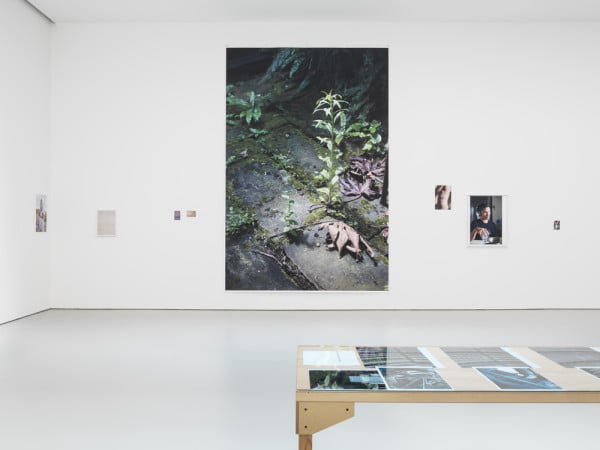
Image: Courtesy of David Zwirner
Wolfgang Tillmans.
Image: Courtesy of Christian Viveros-Faune.
“Life is a state of mind,” a lead character says about the role Peter Sellers plays in Hal Ashby’s movie Being There. The line came to me as I perused Wolfgang Tillmans’s first exhibition of photographs at David Zwirner’s 19th Street gallery (which is on view through October 24). A Johnny-on-the-spot since his discovery of British youth culture in the 1980s, the German shutterbug’s simplicity has often been taken for profundity—nowhere more so than in this show of comely pictures and homely politics.
Street demonstrations and protest movements as cultural memes have hit the zeitgeist like a buzzy new Netflix series this season. They are in full bloom, for instance, in first-time novelist Garth Risk Hallberg’s Tom Wolfe-like City on Fire, in MoMA PS1’s nostalgically anti-commercial take on “Greater New York,” and in Tillmans’ current exhibition—which is thick with what the gallery press release describes as “photographs of activists in New York, Berlin, Osaka, Santiago de Chile and St. Petersburg.” Each of these different expressions features romantic glimpses of life as it actually is (or was) lived, but little in the way of engagement. Adaptability, it turns out, is a state of mind, too.
Changeability and conformism, where the casual transfer of ideas is concerned, are sometimes twin sides of the same coin. Ubiquity, which Tillmans has cultivated for decades, employs that hipster currency for cultural relevance in copycat global locales from Berlin’s Mitte to Shomikitazwa, Tokyo’s Williamsburg. But what happens when the age-old figure of the artist-as-flâneur—Baudelaire’s passionate stroller—increasingly embodies an alt-lifestyle advertisement rather than a “sign of the alienation of the city and of capitalism,” in Walter Benjamin’s formulation? Here’s a radical idea for the age of Syriza and Black Lives Matter: You can’t be the photographer of modern life in the 21st century when you insist on a 19th-century creative model.
Wolfgang Tillmans,
water melon still life (2012).
Photo: Courtesy of David Zwirner.
If Tillmans’ approach to his medium and subject matter produce more coolhunting than critical thought, his photographs—at times intensely personal and full of startling juxtapositions—remain vibrant records of a privileged, rare avis’s passage through this year’s collection of Wallpaper City Guides. Throughout his current show the celebrated photographer enacts Baudelaire’s idea of the artist as “a botanist of the sidewalk”—but with loads of frequent flyer rewards. This is Tillmans’ gift and curse. Almost no matter where or what the German photographs, the world as seen through his camera appears hiply homogenous. Sometimes, it’s as if his globe-spanning tribe of Brooklynites had merely turned up to be shot for the pages of i-D magazine.
But if you’re put off, as I am, by Tillmans’ relentlessly boho content, there’s no arguing with his inventiveness—or his ability to make formal connections through smart, lively installations. His pictures, printed in a bewildering array of sizes—at Zwirner, some are framed C-prints and others inkjet prints attached directly to the wall—are often arranged with rhyming asymmetries. One corner, for instance, contains five modest-sized horizontal and vertical pictures; stand at the correct angle, and they line up with an upright photograph in a previous room of two men playing “pocket pool.” Another wall displays a photo that is left to dazzle individually: A framed print of a red-stained white plate atop a watermelon rind, it recalls nothing so much as a punch in the teeth.
Installation view of “Wolfgang Tillmans PCR” at David Zwirner.
Image: Courtesy of David Zwirner.
Elsewhere, Tillmans displays abstract monochromes in beige and green—photographs, sometimes folded into sculptural forms, which the artist made after exposing photosensitive paper to colored light in the darkroom. Notably, the German gave up film to become a full-time digital photographer in 2012. This accounts for the high-definition look of a number of his current pictures, such as the exhibition’s two large seascapes. Tillmans’ crush on new technologies is also in evidence in several state-of-the-art nightscapes—made while driving on the Sunset Strip, they are as clean as a squeegeed windshield—and a huge print of the grainy noise of a television screen. In the last case especially, one wishes the German were more attentive to certain critiques of technology that do not fit into his mostly enthusiastic worldview.
Installation view of “Wolfgang Tillmans PCR” at David Zwirner.
Image: Courtesy of David Zwirner.
The title of Tillmans’ current exhibition is “PCR,” an abbreviation for “polymerase chain reaction,” a technology in molecular biology which the artist invokes to suggest the endlessly recombinatory possibilities of a single image or network of images. It is, in sum, a cornflakes and sunshine metaphor for the current politics of image circulation. But the techno-optimism built into this trope does not serve the German photographer well, or help accurately frame his exhibition of good-looking photographs. A useful platitude —like “Life is a state of mind”—this go-along idea trades studiedly careless snapshots of protesters for meaningful social critique, and timely slogans for deep thoughts.
“Wolfgang Tillmans PCR” is on view at David Zwirner through October 24.